Plant of the Month: December 2012
|
| Kunming Knotweed; |
| Polygonum microcephalum var. sphærocephalum (Wall. ex Meisn.) H. Hara 1971 'Kunming' |
| = Polygonum sphærocephalum Wall. ex Meisn. 1832 |
| = Polygonum Thunbergii hort., non S. & Z. 1846 'Langthorn's Variety' |
| = Persicaria sphærocephala (Wall. ex Meisn.) H. Gross. 1913 |
| = Persicaria alata hort., non (Buch.-Ham. ex D. Don) Nakai1914 |
| = Persicaria nepalensis hort., non (Meisn.) H. Gross 1913 |
| = Persicaria sp. Kunming hort. |
POLYGONACEÆ; Knotweed Family
|
| In 1997, or earlier, my Seattle gardening friend Jon Nielsen supplied me with a start of an attractively colorful perennial groundcover plant. The species name used, Polygonum Thunbergii 'Langthorn's Variety' --was quickly found to be inaccurate. Polygonum Thunbergii is an East Asian annual. Our clone in question is perennial, so cannot be this species. Until October 2012, I have wondered what the plant's proper specific name was. I am still not sure, but this article details what I have learned. The photos below were taken on October 14th. |
| First, whether to "lump" all knotweeds into genus Polygonum, or "split" some into Persicaria, is a matter of opinion. I prefer to lump. Whether the genus preferred is Polygonum or Persicaria, does not matter, because it is the species name I seek. The European Garden Flora 2011 also lumps --but oddly lacks my present subject. |
| To figure out what my plant's species name was, first I examined the plant closely, botanically: rhizomatous groundcover with deciduous upright stems to 37 cm tall, clothed with recurved hairs. Leaves ovate; to 6.5 x 3.5 cm; chevron blotched; cordate, sagittate or cuneate at base; apex acute; margin ciliate; petiole short, winged. Achene (seed) to 2.5 mm. |
Consulting the online Flora of China, volume 5, I worked through its key of 99 Polygonum species, and came up with the following as the best fit.
|
| Polygonum microcephalum var. sphærocephalum (Wall. ex Meisn.) H. Hara 1971 |
| "Herbs perennial. Rhizomes stout. Stems erect or decumbent, 40-60 cm tall, angulate, branched. Petiole 1-1.2 cm, winged; leaf blade broadly ovate or triangular-ovate, 6-10 x 2-4 cm, both surfaces glabrous or pilose, base subrounded, decurrent along petiole forming a wing, margin entire, ciliate, apex acuminate; ocrea tubular, lax, 7-10 mm, pubescent, apex truncate, ciliate. Inflorescence terminal, usually geminate, capitate, 5-7 mm in diam.; peduncle glabrous or glandular hairy; bracts ovate, apex acute. Perianth white or pinkish, 5-parted; tepals elliptic, 2-3 mm. Stamens 8, included. Styles 3, connate to below middle; stigmas capitate. Achenes black-brown, opaque, broadly ovoid, trigonous, 2-2.5 mm, punctate." |
| The typical species (xiao tou liao): "Mixed forests on mountain slopes, grassy places in valleys; 1000-2000 m. S Gansu, Guizhou, Hubei, Hunan, SW Shaanxi, Sichuan, Xizang, Yunnan [Bhutan, NE India, Nepal, Sikkim]." |
The variant (xian geng xiao tou liao): "Forests, grassy slopes; 500-3200 m. Hubei, S Shaanxi, Sichuan, Xizang, Yunnan [India, Nepal]."
|
Then I did Google searches to see if any nurseries or authors were using the Flora of China name for the plant. Rowden Gardens came closest (see below). I located various nurseries that I guess --from words and photos-- are selling the plant, or a clone similar to it. Below, I quote from some such finds, using their names and descriptions:
|
| Roots & Rhizomes has it as Persicaria alata. |
| Exclusive Plants has it as Persicaria nepalensis. "Crisp foliage emerges with a deep crimson chevron, that deepens further. Pretty pale pink flowers in summer." |
| The Plantsman's Preference, and Touchwood Plants & Seeds, have it as Persicaria nepalensis. |
| Keeping It Green nursery, Stanwood, Washington, has Persicaria 'Langthorn's Variety'. |
| Richbar Nursery's 2003 Cariboo Gardening Guide had Persicaria Thunbergii 'Langthorn's'. |
| Avalon Gardens has a photo of Persicaria 'Langthorn's Variety. |
| The Flower Factory nursery of Wisconsin has Polygonum sp. Langthorn's Variety. |
| A 2005 Fine Gardening magazine article has "Bad plant number two, at least for me, is 'Persicaria thunbergii 'Langthorn's Variety' (Zones 3-8). What a mess this British import created in the garden. At first, I liked its silver, black, and red leaves, but it quickly. . ." |
| The Cultivated Plant Code (ICNCP Art. 19.19-19.20) prohibits the word variety within a cultivar name. Apparently, there is no International Registration Authority for cultivar names in the knotweeds. |
| I guess that the incorrect Langthorn's Variety name refers to Langthorns Plantery --an English nursery established in 1977-- and was applied by a grower who obtained the clone from that source, likely under another name. |
| Other garden cultivars featuring the Langthorns name include: Geranium phæum 'Langthorns Blue', Iris 'Langthorns Pink', Polygonatum 'Langthorns Variegated', and Symphytum 'Langthorns Pink'. |
| Rowden Gardens has both Persicaria alata "(A creeping plant with very prettily marked leaves. Excellent for trailing and in hanging baskets. We have been amused to find this plant being sold as 'Devon Ivy')" and P. microcephala "(The leaves of this densely spreading little thug are entrancingly marked with silver and bronze zoning. Best for the wild garden. The little white balls of flower are not very significant. 1.5 ft.)." |
Under the name Persicaria microcephala, cultivars sold include the common 'Red Dragon' (Far more clumping, taller, and larger leaved than my clone. See photos below.) and also: 'Silver Dragon', 'White Dragon', 'Chocolate Dragon' and 'Purple Fantasy'.
|
| The most complete online account I located about variegated knotweeds used as garden plant ornamentals, is at Alternative Eden: (www.AlternativeEden.com). |
| Persicaria sp. Kunming. "One of the most, if not the most colourful persicaria you can plant in your garden. The intensity of its colour and markings changes dramatically throughout the season, coming up very intense pink in the spring which lasts for a couple of weeks before toning down to apple green with pink leaf margins and stems in late spring. By early summer the colours and markings intensify again but looking more purple than pink with an attractive gradient, and by midsummer onwards the colour tones down again to apple green but not losing its chevron marking. It also liberally sends out dainty flowers but they are barely noticeable on top of such attractive foliage." |
"For all its beauty, do site this plant carefully as it can be rampant and can quickly cover a sizeable area in no time at all, which makes it a great ground cover plant if ever you need one. Even with its vigour I find it easy enough to control by severing and removing wandering rhizomes in the autumn which are fortunately superficial and easy to pull out. Make sure you bin all of the cuttings rather than composting them to prevent unwanted spread. Or you can always just keep it in a pot which will definitely restrict its spread."
|
| In conclusion, I guess the Kunming Botanical Garden, in Yunnan Province, China, may be the source of this clone, or of the seed from whence it grew. If the clone is not a variant of Polygonum microcephalum, it at least is more closely related to that species than to the others it has been ascribed to. If any readers care to share more details, I shall be pleased, and can update this article. |
Incidentally, because my garden features only plants that are fragrant or edible, you should know that I eat the tender growing tips and flowers of this plant. Virtually all knotweeds are edible, save those that are too hairy to chew. Most taste bland, a few species are pleasingly acidic as sorrel.
Back
|
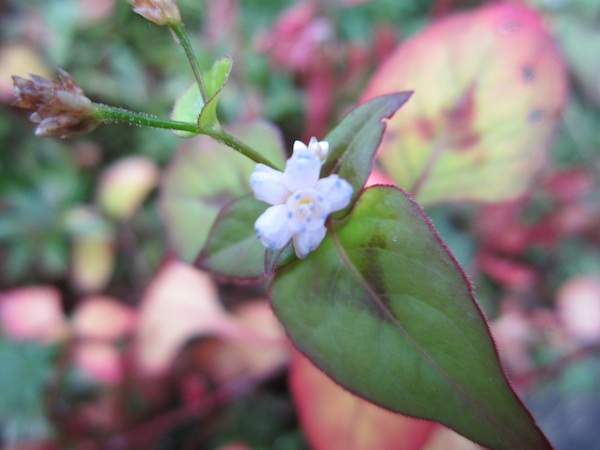
Kunming Knotweed flowers; photo by ALJ
|
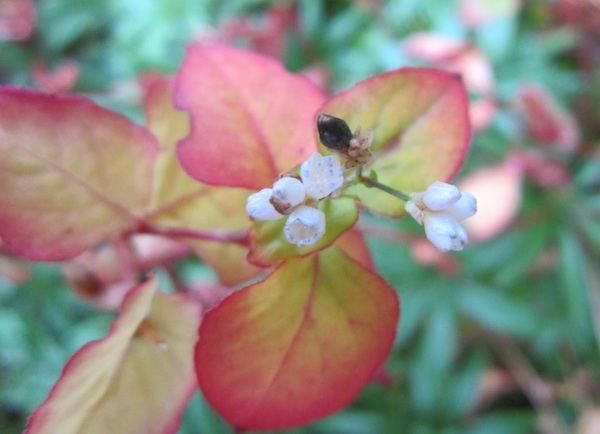
Kunming Knotweed flowers and seed; photo by ALJ
|
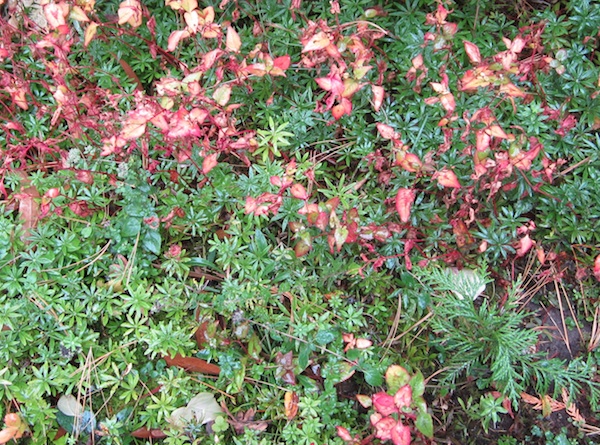
Kunming Knotweed fall color; photo by ALJ
|
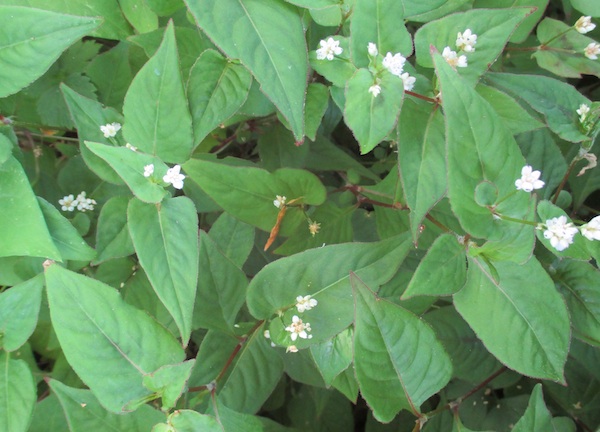
Kunming Knotweed reverted to all green; photo by ALJ
|
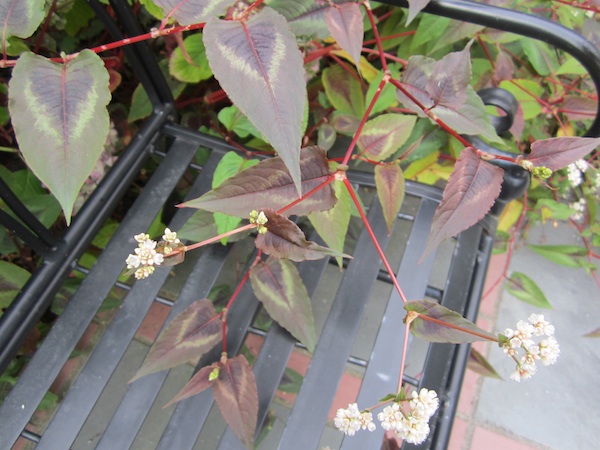
'Red Dragon' Knotweed; photo by ALJ
|
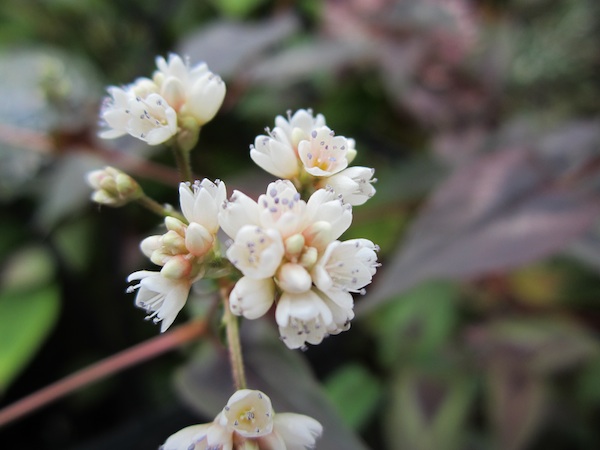
'Red Dragon' Knotweed flower close-up; photo by ALJ
|
|
|

